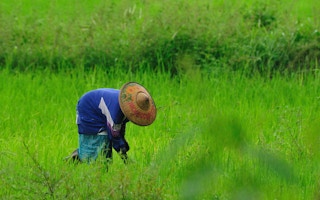If you were to drive through farmland in rural Java, Indonesia, on a recent morning and roll down your car windows, you probably wouldn’t take in the wet grass smell of the rice paddies. Instead, you might get an odor more like a chemistry lab.
Out in the fields, farmers are spraying chemical pesticides. It is a typical scene with pesticide use in Southeast Asia having increased ten times in the last decade with further hikes likely. The reason? The Fall armyworm.
The army worm invaded Southeast Asia in late 2018 with first reports coming from Thailand and Myanmar. Fall armyworms tend to feed voraciously in large groups on multiple crops. The pest’s ability to devastate crops is terrifying for farmers and will likely trigger ever higher use of pesticides.
In Africa, where the armyworm invaded in 2016, a study in Ethiopia and Kenya showed that most smallholder farmers there relied on chemical pesticides, some highly toxic for human, as pest rampaged through fields. If similar trends were to happen in Southeast Asia, this would be a disaster in a region already weary of agrochemicals.
Big agricultural companies have been selling chemical pesticides to farmers as the main solution to insect management for the last 70 years.
Last week, Asian countries gathered in Bangkok to formulate best response to fall armyworm invasion, the time is ripe for a fresh thinking in insect management. What if the established pesticide industry chose to respond to the fall armyworm invasion by switching a large part of their production and distribution lines to biopesticides?
Manufacturing and sales of chemical pesticides started as a big agricultural industry right after the Second World War. Chemical pesticides’ arrival in the food production scene was first hailed as a miracle. According to one estimate, pesticide use saves about 30-50 per cent of food that would have been lost to insects and diseases.
Smallholder farmers produce around 80 per cent of global food supply. Smallholder farmers in Asia are also the ones most likely to over use pesticides. These same farmers usually have the least access to information on proper pesticide use and are the least likely to own equipment needed to use pesticides safely.
The human cost of this situation is immense. Repeated pesticide exposure has been linked to increased risk of cancer, asthma, diabetes, Parkinson’s disease, leukemia and other diseases. When the health costs are factored in, pesticide overuse yields very little or even no profit for farmers.
Amidst all of this, a scientific revolution is brewing. Spearheaded by several startup companies in North America, a number of alternatives to chemical pesticides are reaching the market. Terramera, a Canadian company, markets plant-based biopesticides that are much safer for growers and consumers.
A biodegradable spray-on barrier that protects plants from pesky pests is another solution championed by Crop Enhancement, a startup company out of Boston. Provivi, another startup out of Santa Monica, is bringing pheromone-based solutions to protect staple crops in developing countries.
Biopesticides, such as the three examples above, are typically less toxic to human and other organisms such as fish, bees and birds compared to conventional pesticides. In the past, biopesticides were notorious for being less effective or expensive to produce.
For example, a few decades ago pheromone-based solutions were only economically viable for high value crops such as apples. But the rise of biopesticide startups indicates that the costs of these solutions is lowering while the research shows that their effectiveness in managing pests is improving.
“
The fall armyworm invasion also provides an opportunity for the big agricultural companies to introduce another miracle by mainstreaming biopesticides and usher a new era of safer food production.
It is a good time to join the biopesticide revolution. Currently, biopesticides command only a 5 per cent of the global crop protection market. However, a five year forecast put a global growth rate of biopesticide market at about 14 per cent, much higher than the about 5 per cent growth rate for synthetic pesticide market for the same period. Indeed, at the current pace of growth, biopesticide market size is projected to match synthetic pesticide’s by late 2040.
It also seems to be getting cheaper and faster to develop biopesticide products compared to synthetic pesticides. One estimate put the development cost for a new synthetic pesticide at USD $286 million with the average development time of 12 years. Marrone Bioscience, a biopesticide company, indicates that a biopesticide product costs USD 3-7 million to develop with only 3-4 years research time.
The shift for established pesticide companies from primarily producing and selling chemical pesticides to biopesticides may feel like self-disruption. The short-term costs of such exercise are immense but achievable. The strongest argument for this shift, however, may come from the market.
As Asian consumers grow weary of pesticides in their food and smallholder farmers suffer from chronic exposure to toxic chemicals, there is a ready market in Asia for biopesticides to manage pests such as fall armyworm.
In this context, it is maintaining business as usual that may prove too costly for the big agricultural companies as biopesticide startups begin to disrupt the industry and win market share.
Over seventy years ago when chemical pesticides were first introduced to farmers they were seen as a miracle to manage pests. The fall armyworm invasion of Southeast Asia may herald a wave of panic spraying among smallholder farmers in the region.
However, in the Churchillian spirit of never wasting a good crisis, the fall armyworm invasion also provides an opportunity for the big agricultural companies to introduce another miracle by mainstreaming biopesticides and usher a new era of safer food production.
Imagine the impact if these companies, with their established distribution channels, decide to shift large parts of their production lines to biopesticides. The market would be flooded with products to manage pests which would also be safer for farmers and consumers alike.
Buyung Hadi is an Indonesian entomologist working on sustainable rice production. He is based in Cambodia and the opinion expressed here is his own.
Like this content? Join our growing community.
Your support helps to strengthen independent journalism, which is critically needed to guide business and policy development for positive impact. Unlock unlimited access to our content and members-only perks.


















